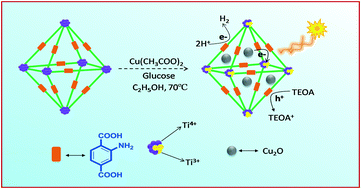Efficient solar light-driven H2 production: post-synthetic encapsulation of a Cu2O co-catalyst in a metal–organic framework (MOF) for boosting the effective charge carrier separation†
Abstract
The development of new and efficient catalytic systems for solar light-driven hydrogen generation is one of the prime focuses of contemporary chemical sciences. Indeed, the charge carrier separation efficiency of a photocatalyst plays a vital role in photocatalysis. Herein, we have successfully designed a Cu2O-encapsulating NH2-MIL-125(Ti) MOF by a post-synthetic encapsulation strategy. The Cu2O-encapsulating MOF material showed a remarkable enhancement in photocatalytic H2 production activity under solar light illumination. Gratifyingly, the H2 production activity under solar light was around ∼28-fold higher than that of the pristine MOF. The enhancement in photocatalytic activity may be attributed to efficient charge carrier separation through Ti3+ sites and the broad light absorption of the Cu2O-encapsulating MOF photocatalyst. The possible electron transport mechanism, potential energy diagram (V vs. NHE), and the existence of Ti3+ ions have been demonstrated by various spectroscopic studies.



 Please wait while we load your content...
Please wait while we load your content...